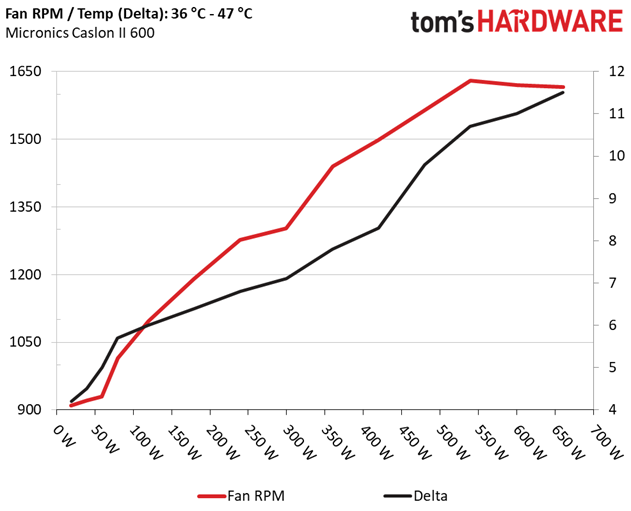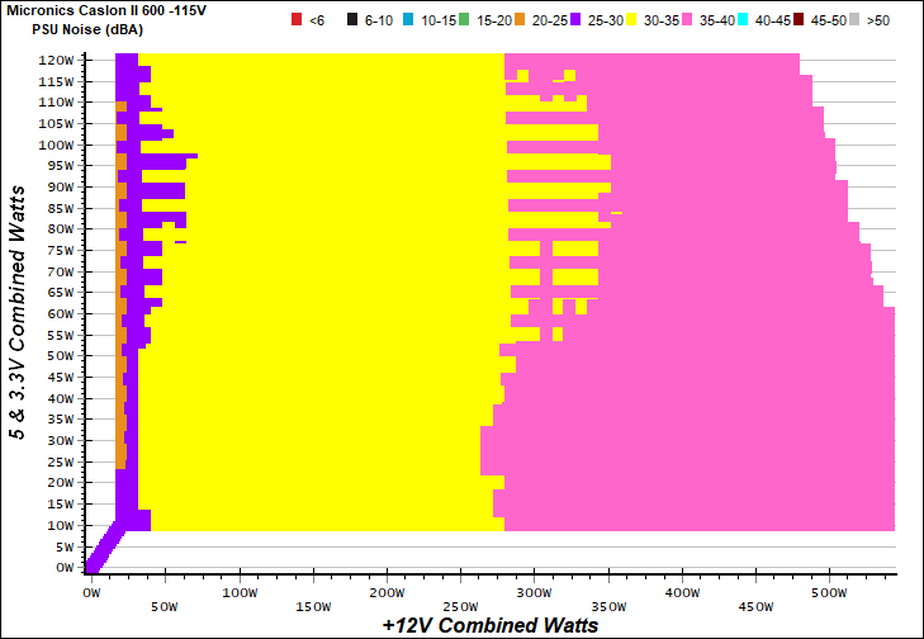Micronics Caslon II 600W PSU Review: A Low-Cost Gem?
Why you can trust Tom's Hardware
Efficiency, Temperature & Noise
Efficiency
Our efficiency testing procedure is detailed here.
Using results from the previous page, we plotted a chart showing the Caslon II’s efficiency at low loads, and loads from 10 to 110 percent of its maximum-rated capacity.
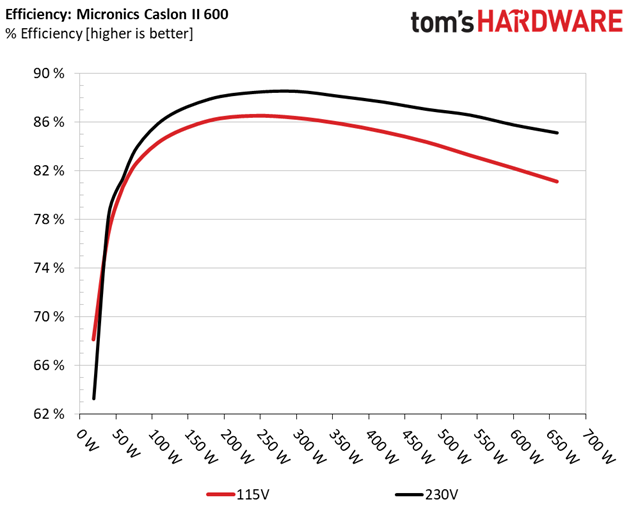
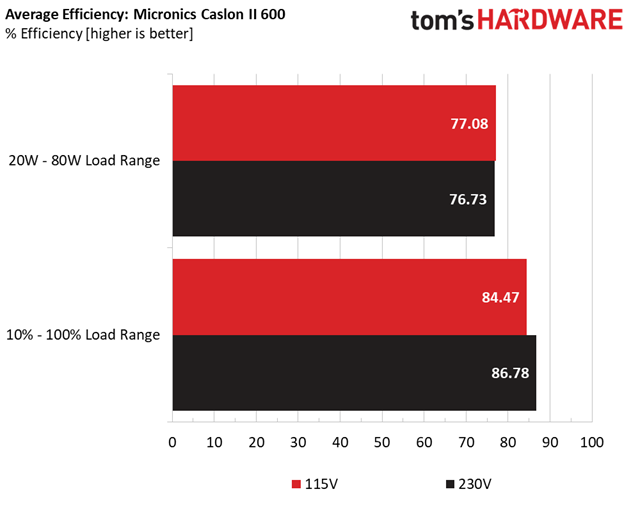
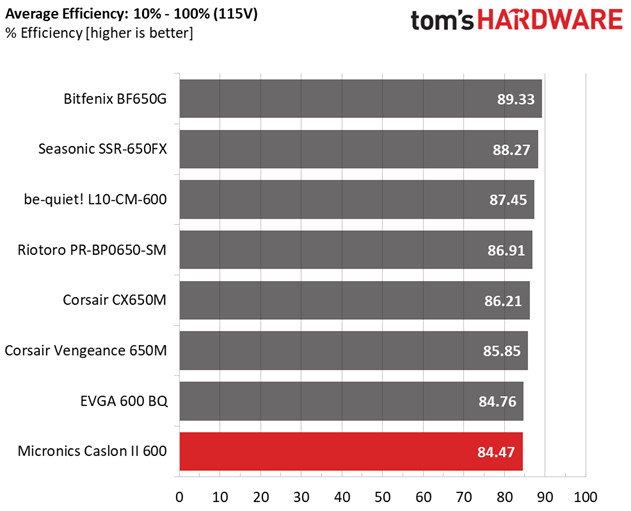
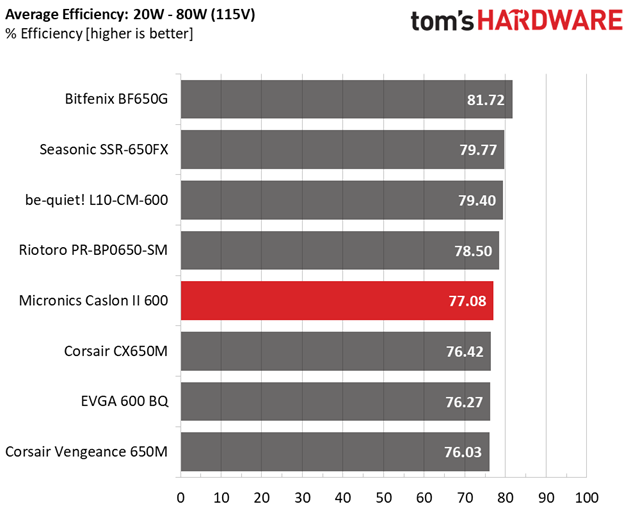
Overall efficiency under normal loads is low, while the situation gets better with light loads.
Efficiency At Low Loads
In the following tests, we measure the Caslon II's efficiency at loads significantly lower than 10 percent of its maximum capacity (the lowest load the 80 PLUS standard measures). The loads we dialed were 20, 40, 60, and 80W. This is important for representing when a PC is idle, with power-saving features turned on.
| Test # | 12V | 5V | 3.3V | 5VSB | DC/AC (Watts) | Efficiency | Fan Speed | PSU Noise | PF/AC Volts |
|---|---|---|---|---|---|---|---|---|---|
| 1 | 1.178A | 0.482A | 0.470A | 0.194A | 19.298 | 68.121% | 910 RPM | 25.8 dB(A) | 0.788 |
| 12.071V | 5.170V | 3.378V | 5.147V | 28.329 | 115.24V | ||||
| 2 | 2.441A | 0.967A | 0.974A | 0.390A | 39.724 | 76.809% | 921 RPM | 25.9 dB(A) | 0.923 |
| 12.064V | 5.158V | 3.376V | 5.130V | 51.718 | 115.21V | ||||
| 3 | 3.636A | 1.454A | 1.451A | 5.115A | 59.243 | 80.680% | 930 RPM | 26.1 dB(A) | 0.974 |
| 12.063V | 5.147V | 3.374V | 5.115V | 73.430 | 115.18V | ||||
| 4 | 4.897A | 1.945A | 1.955A | 0.784A | 79.674 | 82.709% | 1006 RPM | 28.5 dB(A) | 0.961 |
| 12.066V | 5.139V | 3.372V | 5.101V | 96.330 | 115.15V |
With light loads, the Caslon II achieves decent performance given its low efficiency certifications.
5VSB Efficiency
The ATX specification, along with CEC, ErP Lot 3 2014 and ErP Lot 6 2010/2013, states that 5VSB standby supply efficiency should be as high as possible, recommending 75 percent or higher with 550mA, 1A, and 1.5A of load. The PSU should also achieve higher than 75% efficiency at 5VSB under full load, or with 3A if its max current output on this rail is higher than 3A.
We take six measurements: one each at 100, 250, 550, 1000, and 1500mA, and one with the full load the 5VSB rail can handle.
Get Tom's Hardware's best news and in-depth reviews, straight to your inbox.
| Test # | 5VSB | DC/AC (Watts) | Efficiency | PF/AC Volts |
|---|---|---|---|---|
| 1 | 0.100A | 0.516 | 66.409% | 0.115 |
| 5.156V | 0.777 | 115.36V | ||
| 2 | 0.250A | 1.287 | 75.484% | 0.212 |
| 5.147V | 1.705 | 115.37V | ||
| 3 | 0.550A | 2.821 | 79.398% | 0.307 |
| 5.128V | 3.553 | 115.35V | ||
| 4 | 1.000A | 5.103 | 78.375% | 0.365 |
| 5.103V | 6.511 | 115.36V | ||
| 5 | 1.500A | 7.609 | 78.638% | 0.395 |
| 5.072V | 9.676 | 115.35V | ||
| 6 | 2.500A | 12.508 | 77.096% | 0.429 |
| 5.003V | 16.224 | 115.34V |
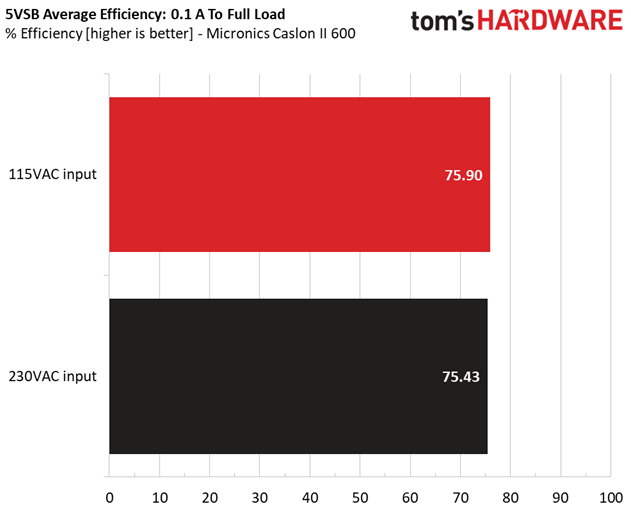

The 5VSB rail is not particularly efficient, matching this PSU's general overall performance.
Power Consumption In Idle And Standby
In the table below, you'll find the power consumption and voltage values of all rails (except -12V) when the PSU is idle (powered on, but without any load on its rails), and the power consumption when the PSU is in standby mode (without any load, at 5VSB).
| Mode | 12V | 5V | 3.3V | 5VSB | Watts | PF/AC Volts |
|---|---|---|---|---|---|---|
| Idle | 12.036V | 5.202V | 3.379V | 5.161V | 10.266 | 0.298 |
| 115.4V | ||||||
| Standby | 0.160 | 0.025 | ||||
| 115.4V |
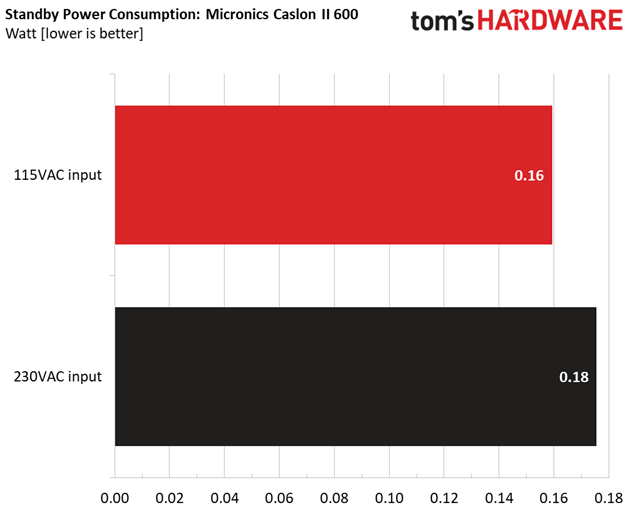
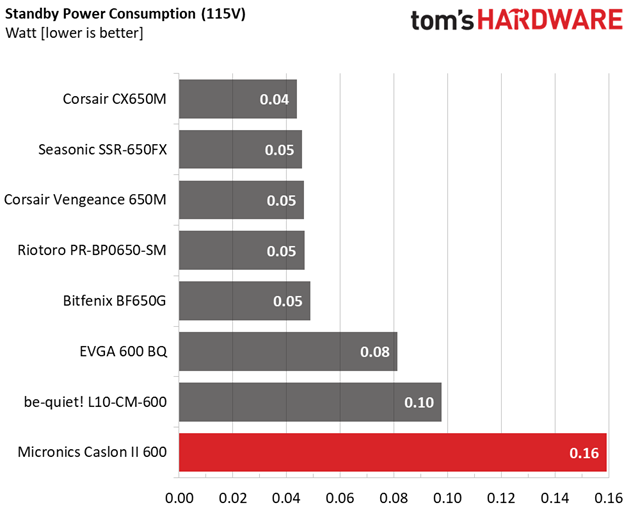
With the zero-wattage mode deactivated, this PSU consumes 0.16W in standby with 115V input, and a bit more with 230V input. Most of the PSUs we test stay below 0.1W with 115V.
Fan RPM, Delta Temperature, And Output Noise
Our mixed noise testing is described in detail here.
The first chart below illustrates the cooling fan's speed (in RPM), and the delta between input and output temperature. The results were obtained at 36°C (96.8°F) to 47°C (116.6°F) ambient temperature.
The next chart shows the cooling fan's speed (again, in RPM) and output noise. We measured acoustics from one meter away, inside a hemi-anechoic chamber. Background noise inside the chamber was below 6 dB(A) during testing (it's actually much lower, but our sound meter’s microphone hits its floor), and the results were obtained with the PSU operating at 36°C (96.8°F) to 47°C (116.6°F) ambient temperature.
The following graph illustrates the fan's output noise over the PSU's operating range. The same conditions of the above graph apply to our measurements, though the ambient temperature was between 30°C (86°F) to 32°C (89.6°F).
The fan profile is not loose, which we expected since this platform offers low efficiency levels. With up to around 275W, the PSU is in the 30-35 dB(A) range, while higher loads push it closer to 40 dB(A). If you need a quiet PSU, then shop for a more efficient one.
MORE: Best Power Supplies
MORE: How We Test Power Supplies
MORE: All Power Supply Content
Current page: Efficiency, Temperature & Noise
Prev Page Load Regulation, Hold-Up Time & Inrush Current Next Page Protection Features
Aris Mpitziopoulos is a contributing editor at Tom's Hardware, covering PSUs.
-
nobspls Why would anyone choose this one say over the Corsair CX650M? Which you can get typically for $50.Reply -
spentshells " Not only does this minimize your carbon footprint"Reply
The idea of conserving electricity is a fallacy, if you use less the people selling can sell more to someone else..... they aren't just holding on to the energy you saved because you're a hero saving the world.
Making your footprint smaller doesn't matter in the least when someone else's foot print just gets that much bigger.
Save some money, sure but for how long? The less you use the more they can charge for that smaller amount later on..... that's how it is.
On a different note, Ill likely try the psu out at one point on a build for someone else. -
rohs42 > The idea of conserving electricity is a fallacyReply
No it isn't. Of course a 100 megawatt generator will not be turned off if someone saves 10 watts of power. But if a 10 million people save 10 watts of power, then of course it will be turned off. And if 100 million people save 10 watts, then there'll be no business case for that new gigawatt power plant.
As citizens, consumers and voters we all bear a small share of responsibility for the state of the world, and we all have a small part to play in making it better. It's only through working together that humanity improves. Your appeal to helplessness and apathy is pathetic. -
jabliese Hey Tom's,Reply
Once upon a time, we had an extensive brown out at work, which went on for 3 days. On day 2, I was surprised to find many of the PC's that were still working were on 60v power. Over the years, it did not seem to have a adverse affect on any of the power supplies. Lately, I have been wondering what their efficiency numbers looked like during that time, any chance you could add a severe undervolt test to the power supply suite? -
Aris_Mp 60V is too low. Most PSUs won't even work at such low voltage. I am surprised to hear that the PSUs at your work were working under such conditions for days.Reply
Efficiency drops along with voltage input. I want to add more protection tests, however I already have enough fails with the current ones. Nonetheless, I am keeping every suggestion under consideration.
